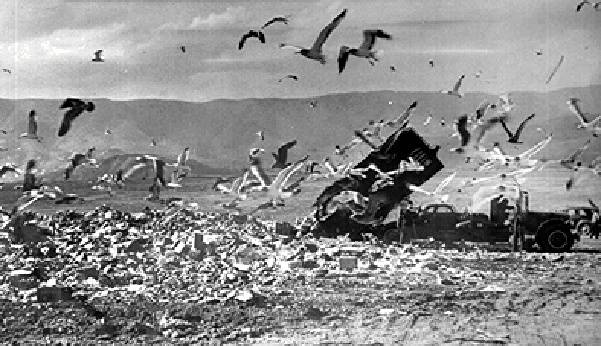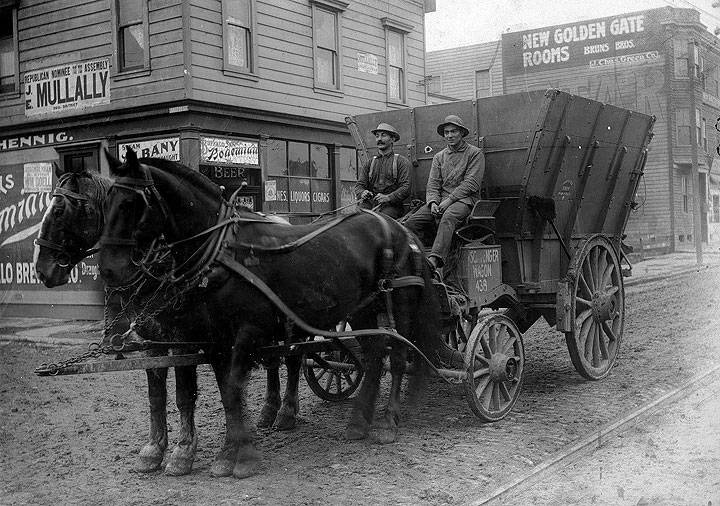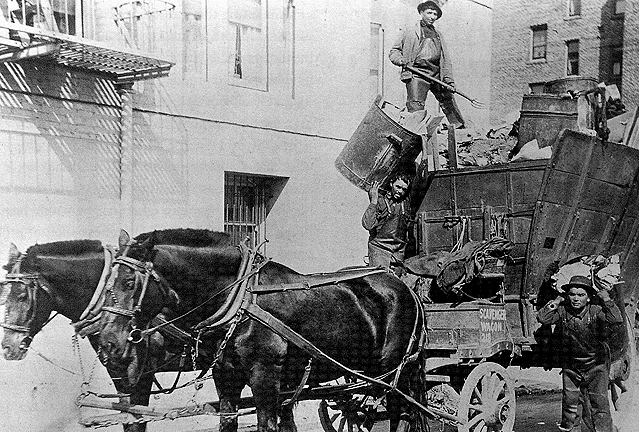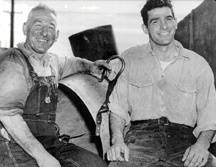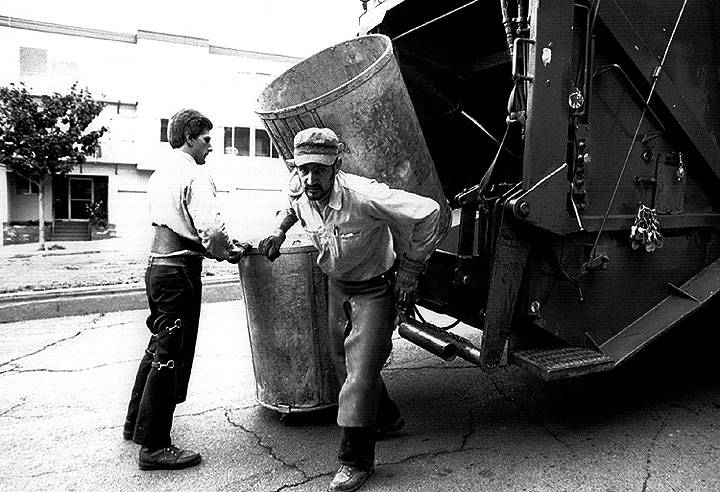Scavengers: Difference between revisions
m (Protected "Scavengers": finished essay [edit=sysop:move=sysop]) |
(added new photo) |
||
| (2 intermediate revisions by the same user not shown) | |||
| Line 8: | Line 8: | ||
''Photos: San Francisco History Center, SF Public Library'' | ''Photos: San Francisco History Center, SF Public Library'' | ||
[[Image:Belli.jpg]] | |||
'''[[Daughter of a Sunset Scavenger|Ines Belli]]’s father and uncle, circa 1912.''' | |||
''Photo courtesy Ines Bell'' | |||
[[Image:Scavs930.gif]] | |||
'''Scavengers on the job, 1930s.''' | |||
''Photo: Private Collection'' | |||
San Francisco now has only one garbage collection company (Sunset, formed in 1921), but it was formed out of many different companies, almost all of them Italian. | San Francisco now has only one garbage collection company (Sunset, formed in 1921), but it was formed out of many different companies, almost all of them Italian. | ||
| Line 15: | Line 27: | ||
One of the largest of the companies was the Scavengers Protective Association, which was founded by Andrea Sbaboro, one of the prominenti of the city. Another large company was started before WWI by Emilio Rattaro as the Sunset Scavenger Company with about 100 workers (there were about 400 garbage men in the city). After city legislation in 1920 specified districts and rates, Sunset was formally incorporated in 1921. | One of the largest of the companies was the Scavengers Protective Association, which was founded by Andrea Sbaboro, one of the prominenti of the city. Another large company was started before WWI by Emilio Rattaro as the Sunset Scavenger Company with about 100 workers (there were about 400 garbage men in the city). After city legislation in 1920 specified districts and rates, Sunset was formally incorporated in 1921. | ||
In 1932 there were a total of 97 districts served by 36 companies. Yet the Depression took a toll, and by 1935 there were only three districts. In 1939 the Sunset Scavengers (then run by Leonard Stefanelli) bought Mission Scavengers, leaving only two districts: Sunset and the Scavengers Protective Association. | In 1932 there were a total of 97 districts served by 36 companies. Yet the Depression took a toll, and by 1935 there were only three districts. In 1939 the [[San Francisco's Trash|Sunset Scavengers]] (then run by Leonard Stefanelli) bought Mission Scavengers, leaving only two districts: Sunset and the Scavengers Protective Association. | ||
During WWII garbage men were exempt from the draft, but some left for better-paying jobs in industry, which led to some Latinos and blacks joining the companies. In a few years several Latinos were accepted as working partners or stock-holders. In general, the Scavengers Protective Association was the only real union in North Beach for many years, incorporating aspects of a cooperative with those of an employee-owned company. During the 1960s and '70s increasing pressure was brought upon the Scavengers to hire more non-Italians. | During WWII garbage men were exempt from the draft, but some left for better-paying jobs in industry, which led to some Latinos and blacks joining the companies. In a few years several Latinos were accepted as working partners or stock-holders. In general, the Scavengers Protective Association was the only real union in North Beach for many years, incorporating aspects of a cooperative with those of an employee-owned company. During the 1960s and '70s increasing pressure was brought upon the Scavengers to hire more non-Italians. | ||
| Line 25: | Line 37: | ||
''Photo: San Francisco History Center, SF Public Library'' | ''Photo: San Francisco History Center, SF Public Library'' | ||
[[Image: | [[Image:GARBMEN2.jpg]] | ||
'''San Francisco Scavengers at work.''' | '''San Francisco Scavengers at work in the 1990s, before the introduction of the [[San Francisco's Trash|curbside recycling]] and plastic bin system.''' | ||
''Photo: Rick Gerharter'' | ''Photo: Rick Gerharter'' | ||
| Line 34: | Line 46: | ||
[[Bank of Italy| Prev. Document]] [[Italians and Sports| Next Document]] | [[Bank of Italy| Prev. Document]] [[Italians and Sports| Next Document]] | ||
[[category:Italian]] [[category:1910s]] [[category:1920s]] [[category:1930s]] [[category:1960s]] [[category:1970s]] [[category:Labor]] [[category:Ecology]] | [[category:Italian]] [[category:1910s]] [[category:1920s]] [[category:1930s]] [[category:1960s]] [[category:1970s]] [[category:Labor]] [[category:Ecology]] [[category:Waste]] | ||
Latest revision as of 21:12, 21 September 2014
Historical Essay
by G. S. Williamson
The Brisbane Dump, in the shadow of San Bruno Mountain, San Francisco's waste disposal for over 30 years. The stench from garbage wafting up to San Bruno Mtn. helped save it from development, since no one wanted to live with that smell!
Photos: San Francisco History Center, SF Public Library
Ines Belli’s father and uncle, circa 1912.
Photo courtesy Ines Bell
Scavengers on the job, 1930s.
Photo: Private Collection
San Francisco now has only one garbage collection company (Sunset, formed in 1921), but it was formed out of many different companies, almost all of them Italian.
In the late 19th century and into the 20th, garbage collection ("scavenging") was controlled by Italians from the area known as Lorsica. Until 1910, when more workers were needed, they were hired from that province in Italy, rather than from among other Italians in North Beach. For the next quarter century the Lorsicani of San Francisco provided enough children to satisfy the need for new workers. This is the period fondly remembered by old time residents, when scavengers wore straw hats (or, occasionally, silk opera hats) and sang opera.
One of the largest of the companies was the Scavengers Protective Association, which was founded by Andrea Sbaboro, one of the prominenti of the city. Another large company was started before WWI by Emilio Rattaro as the Sunset Scavenger Company with about 100 workers (there were about 400 garbage men in the city). After city legislation in 1920 specified districts and rates, Sunset was formally incorporated in 1921.
In 1932 there were a total of 97 districts served by 36 companies. Yet the Depression took a toll, and by 1935 there were only three districts. In 1939 the Sunset Scavengers (then run by Leonard Stefanelli) bought Mission Scavengers, leaving only two districts: Sunset and the Scavengers Protective Association.
During WWII garbage men were exempt from the draft, but some left for better-paying jobs in industry, which led to some Latinos and blacks joining the companies. In a few years several Latinos were accepted as working partners or stock-holders. In general, the Scavengers Protective Association was the only real union in North Beach for many years, incorporating aspects of a cooperative with those of an employee-owned company. During the 1960s and '70s increasing pressure was brought upon the Scavengers to hire more non-Italians.
1953: Charles & John Guanaglia, father and son. Charles worked the same route for 28 years, now his son is taking over.
Photo: San Francisco History Center, SF Public Library
San Francisco Scavengers at work in the 1990s, before the introduction of the curbside recycling and plastic bin system.
Photo: Rick Gerharter

